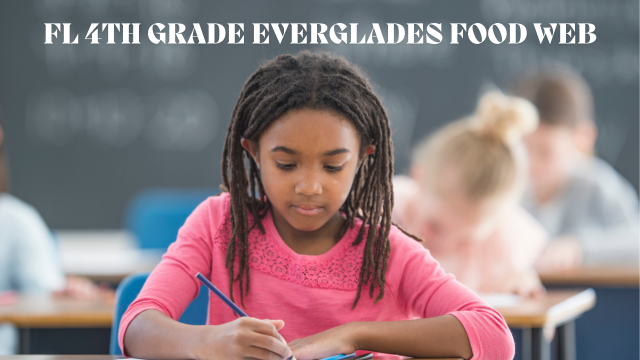FL 4th Grade Everglades Food Web: Best Learning Resources and Tools
The Everglades is one of the most unique and biodiverse ecosystems in the world, providing a rich learning environment for students. For 4th-grade students in Florida, learning about the Everglades’ food web is a core component of understanding ecosystems and environmental science. With a wide array of plants, animals, and intricate relationships, the Everglades offers an ideal backdrop for learning how ecosystems function. In this post, we will explore various educational resources that help teach the FL 4th Grade Everglades Food Web. These learning tools provide students and educators with engaging content, from textbooks and lesson plans to interactive online resources that illustrate the complexities of food chains and food webs within the Everglades.
What Is a Food Web?
Before diving into specific learning resources, it’s essential to clarify what a food web is and why it’s important in studying ecosystems. A food web is a graphical representation of the interconnected relationships between different organisms in an ecosystem, showing how energy and nutrients flow through trophic levels. Unlike a food chain, which follows a single pathway, a food web shows the numerous feeding connections that exist among various species.
The Everglades Ecosystem
The Everglades is a massive wetland system located in southern Florida, known for its diversity of species, ranging from wading birds and alligators to sawgrass and periphyton (algae). Understanding how these species interact is crucial for 4th-grade students learning about the food web. The Everglades has several habitats, including freshwater marshes, mangroves, and pinelands, which support a variety of species, each playing a role in the food web.
Importance of Teaching the Everglades Food Web to 4th Graders
Introducing young students to complex ecological concepts such as food webs at an early age helps develop critical thinking, scientific reasoning, and environmental stewardship. For Florida’s 4th graders, the Everglades food web is particularly relevant due to the state’s proximity to this unique ecosystem. It encourages students to appreciate and understand the delicate balance of nature in their own backyard.
Why Focus on the Everglades?
The Everglades is often referred to as the “River of Grass” and plays an essential role in maintaining Florida’s natural balance. Teaching students about this ecosystem helps them:
- Understand biodiversity.
- Learn how energy flows through an ecosystem.
- Recognize the importance of environmental conservation.
Key Components of the Everglades Food Web
To understand the food web in the Everglades, it’s essential to break it down into its primary components. A food web consists of producers, consumers, and decomposers.
1. Producers
In the Everglades, the most prominent producers include plants like sawgrass, bladderwort, and periphyton. These organisms convert sunlight into energy through photosynthesis, forming the base of the food web.
2. Primary Consumers
Primary consumers in the Everglades feed on the producers. These include herbivorous animals like snails, insects, and some species of fish that eat algae and plant material.
3. Secondary Consumers
Secondary consumers are organisms that eat the primary consumers. Examples include frogs, small fish, and various species of birds that prey on insects and other small animals.
4. Tertiary Consumers
Tertiary consumers are at the top of the food web and include apex predators like alligators, large wading birds such as herons, and some larger fish. These animals have few or no natural predators within the ecosystem.
5. Decomposers
Decomposers, like fungi and bacteria, play a crucial role in recycling nutrients within the ecosystem. When plants and animals die, decomposers break down organic matter, returning nutrients to the soil and water.
Learning Resources for the FL 4th Grade Everglades Food Web
Finding the right educational resources to teach the Everglades food web is essential to engage students and deepen their understanding. Below are some of the best sources to help 4th-grade teachers and students learn about this vital topic.
1. Florida Department of Education (FLDOE) Standards
The FLDOE provides standards and frameworks that guide teachers in aligning lessons with state learning objectives. The Everglades food web is typically covered under environmental science standards, emphasizing ecosystems, energy flow, and species interaction. Teachers can access the Florida Standards through the FLDOE website, which includes specific learning goals for 4th graders.
2. National Park Service: Everglades Education Resources
The National Park Service offers a wealth of free educational materials on the Everglades, including lesson plans, virtual field trips, and videos that illustrate the food web. These resources are tailored for different grade levels and help teachers bring real-world examples into the classroom.
3. PBS LearningMedia
PBS LearningMedia provides a range of videos, activities, and interactive games that teach students about the Everglades’ ecosystem. Their materials cover various topics, including food chains and webs, helping 4th graders visualize the complex interactions within the Everglades.
4. Scholastic Classroom Resources
Scholastic offers educational content that aligns with curriculum standards, including interactive lessons and articles on ecosystems. Their resources can be particularly helpful for 4th-grade students learning about the Everglades food web, offering age-appropriate content that keeps students engaged.
5. Everglades Foundation Educational Programs
The Everglades Foundation offers a variety of educational programs aimed at teaching students about the Everglades. These programs often include downloadable lesson plans, virtual tours, and interactive activities that help students understand the food web, biodiversity, and the importance of conservation efforts in the region.
Teaching Strategies for the Everglades Food Web
In addition to utilizing available resources, teachers should employ effective teaching strategies to make the concept of food webs more accessible to 4th graders. Here are a few methods to consider:
1. Interactive Activities
Interactive activities such as creating food web diagrams, role-playing different species in the Everglades, and using online simulation tools can help students better grasp how energy flows through an ecosystem.
2. Field Trips
Whenever possible, arranging a field trip to the Everglades or a local wildlife preserve offers students the opportunity to experience the ecosystem firsthand. Observing the flora and fauna in person reinforces classroom lessons and enhances understanding.
3. Visual Aids
Utilizing charts, graphs, and other visual aids can be instrumental in helping students visualize the food web. Displaying a large food web diagram in the classroom and allowing students to add to it as they learn can also be an engaging exercise.
4. Collaborative Learning
Group projects and discussions allow students to work together to solve problems related to food webs. For instance, students could collaborate to build a model of the Everglades food web, identifying the different organisms and their relationships.
The Role of Conservation in the Everglades
While understanding the Everglades food web is critical, it’s equally important to discuss the role of conservation in preserving this delicate ecosystem. Human activities, such as land development, pollution, and climate change, have significantly impacted the Everglades.
Teaching 4th graders about conservation efforts helps them understand the importance of protecting ecosystems. Students can learn about various conservation strategies, including water management, wildlife protection, and habitat restoration, which are all crucial for maintaining the Everglades’ balance.
Common Challenges in Teaching the Everglades Food Web
While teaching the Everglades food web can be incredibly rewarding, there are also challenges that educators might face.
1. Complexity of the Topic
Food webs can be complex, with many interconnected parts. Teachers need to break down the information into simpler segments to ensure that 4th graders can grasp the concept.
2. Lack of Access to Field Resources
Not all schools have the means to take students on field trips to the Everglades. In such cases, virtual tours and interactive online tools can serve as alternatives to give students a sense of the ecosystem without leaving the classroom.
FAQs About FL 4th Grade Everglades Food Web Sources
1. What is the food web of the Everglades?
The Everglades food web is the interconnected system of producers, consumers, and decomposers within the Everglades ecosystem. It shows how energy and nutrients flow between organisms, from plants to top predators like alligators.
2. Why is the Everglades food web important for 4th graders?
Teaching 4th graders about the Everglades food web helps them understand ecosystems, biodiversity, and the flow of energy through an environment. It also introduces them to the concept of environmental conservation.
3. What are the main producers in the Everglades?
Key producers in the Everglades include plants such as sawgrass, bladderwort, and periphyton. These organisms convert sunlight into energy through photosynthesis and form the base of the food web.
4. How can I make learning about the Everglades food web fun for students?
Engage students with interactive activities like food web diagrams, online games, and virtual field trips. Hands-on activities like creating models of the food web can also make the learning process more enjoyable.
5. Are there online tools to help teach the Everglades food web?
Yes, several online resources like PBS LearningMedia
, the National Park Service, and the Everglades Foundation offer interactive tools, videos, and lesson plans to help teach the Everglades food web.
Conclusion
The Everglades offers a rich and engaging environment for teaching 4th graders about food webs and ecosystems. By using a combination of online resources, lesson plans, and hands-on activities, educators can ensure that students understand the importance of biodiversity, energy flow, and conservation in this unique ecosystem.







